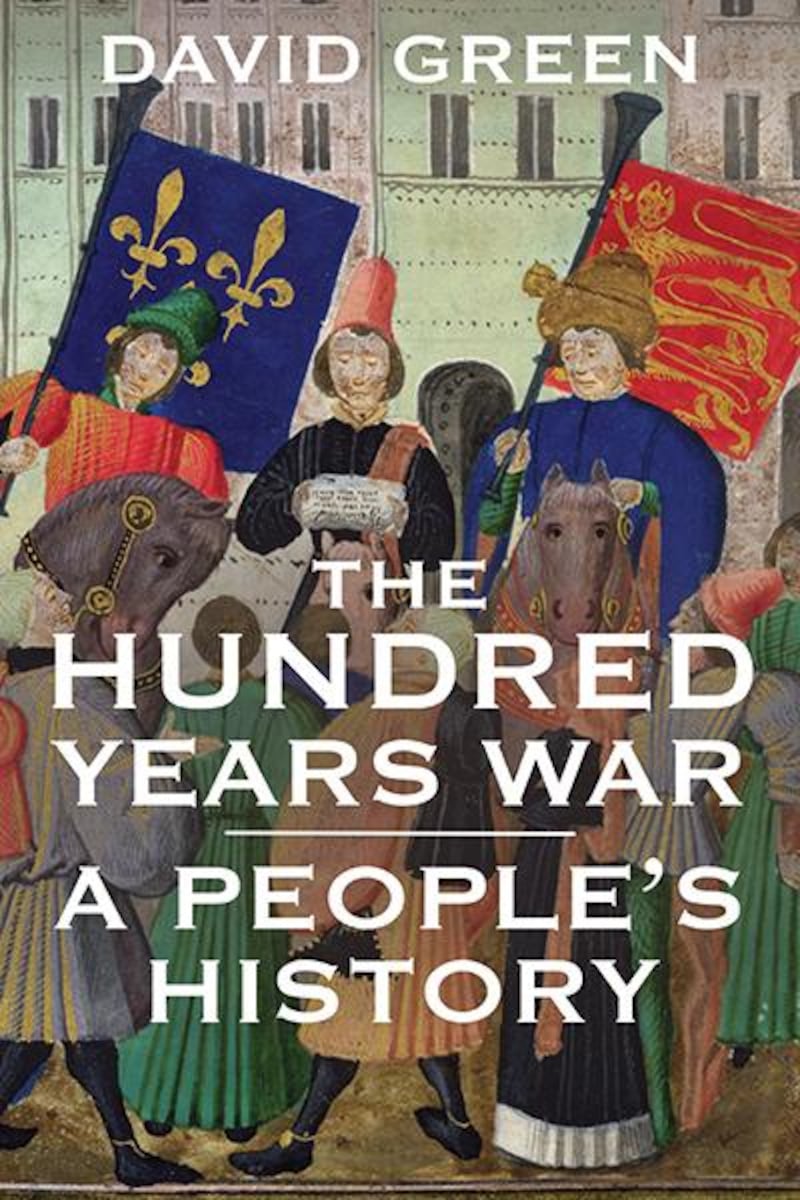As David Green points out at the beginning of his authoritative and absorbing new book, none of the people who experienced the Hundred Years War, which stretched from 1337 to 1453, of course knew the conflict by that name. The designation came centuries later, but The Hundred Years War: A People's History [Amazon.com; Amazon.co.uk] concerns itself almost exclusively with close focus on what Green describes as "a period of vital, vibrant, brutal change".
Popular histories of that period customarily focus on the actions of the great and famous – Henry V at Agincourt, Joan of Arc at Orleans – but Green shifts large parts of the focus of his own book to ordinary civilians: terrified farmers and townsfolk, prisoners of war, rank-and-file clergy and, of course, the tens of thousands of women who mourned their men and helped to defend their homes during one of the most chaotic and violent periods in European history.
That period – the longest war in human history – is famous for isolated battles such as Agincourt and Poitiers, but the war’s origins stretch back to 1066, when William the Conqueror crossed the Channel and took the throne of England from the luckless Harold Godwinson. Although William was now king of England, he was also duke of Normandy, and he thus handed on to his heirs a strange double patrimony in which the kings of one country were also major hereditary landowners in another – with the added complications (Green aptly calls it an “ultimately untenable relationship”) that arose from the fact that the Duke of Normandy technically owed allegiance to the king of France.
As Green points out, the arrangement managed to work with relative stability for a century or so, but during that whole time, through a combination of “marriage, conquest, diplomacy, and good fortune”, England’s possessions in France – the Angevin Empire – were steadily growing, eventually encompassing Anjou, Brittany, and Gascony. These holdings flourished under the strong rule of England’s King Henry II and his son Richard, who were more influential rulers in France than the country’s actual ruling dynasty, the Capetians and then their Valois branch. When the French king Philip VI confiscated the Angevin holdings of Gascony in 1337, the action had the air of inevitability that all momentous military conflicts have at their onsets. The English king, Edward III, had refused to pledge his feudal loyalty to his nominal overlord, Philip, and Philip had reacted as he would with any other obstreperous duke. Edward’s response was to proclaim himself the rightful king of France, and his son, the Black Prince, invaded France in the summer of 1346, devastating the Cambrésis region in the north and soundly defeating the French at the Battle of Crécy.
Green’s approach to narrating the sprawling century of intermittent violence and tense truces that followed is more heavily thematic than most accounts of the Hundred Years War. Despite the fact that hostilities erupted due to the personality clashes of two kings (it’s difficult to envision the same testy sequence of events happening between Edward’s heir, the ineffectual Richard II, and Philip’s heir, the kind-hearted Jean II, for instance), Green traces the impulses and impacts of war through many levels of society, both in England and on the continent. It’s a fruitful and very involving approach, frequently managing to put human faces on what can often be impersonal passages of military history in other accounts.
Green explores, for instance, the sordid and frightening new realities imposed by English occupation on the French citizens in places such as Brittany, Gascony and Normandy (and in Paris itself for a large part of the war), where the English policies “tended to be brutal”. As Green puts it: “Indeed, some native populations were deliberately displaced, to be replaced with more trustworthy settlers.” Some of the stories Green relates about the tensions and angers of these occupations will be all too familiar to people reading the news six centuries later, right down to ugly little scenarios such as the one that happened in Rouen in 1427, when, as Green relates, “English soldiers were recounted as shouting at the French inhabitants to ‘speak English’.”
We’re taken inside the world of church and clergy during the years of the war, which “began with a flurry of bulletins, broadsides, and manifestos” on both sides, a sophisticated machinery of propaganda largely created and sustained by the clergy. The lives of women and children living in terror during active fighting years is well sketched, as are the fascinating details Green provides of the sometimes extraordinary lengths the civilian population would go to in order to save themselves from destruction at the hands of the various armies marching around France. These extraordinary reactions quickly came to be indifferent to the livery of the armies in question. “When soldiers of whatever sort approached a settlement,” Green writes, “some communities would flee almost in their entirety.” Some of these communities fled to elaborate tunnels, souterrains-refuge, with dozens of chambers and well-constructed air shafts. And sometimes, of course, flight wasn’t possible. “Women in the besieged city of Orleans in 1428-29 are also recorded in assisting with the defence,” Green writes, “carrying items such as water and oil, fat, lime and ashes; some were engaged more actively and pushed the attackers from the walls.”
Most centrally, of course, Green deals with the knights on both sides. In many ways, the Hundred Years War was the consummation of knighthood; the calling was at its most refined throughout the 14th century, and yet its doom was fast at hand. “The knight had acquired his august position, his social kudos and cultural cachet, because of his skills as a mounted warrior,” Green writes. “However, the tactics the English adopted in the Hundred Years War did not rely on heavy cavalry; indeed, they were developed to counter its use.” The famed English longbow, the key to such iconic victories as Agincourt, had instead come to rule the battlefield, its bolts capable of piercing plate armour and its professional archers capable of unleashing a cloud of fire that could throw even the most impressive mounted cavalry charge into complete confusion. It was just this kind of devastating innovation that turned the Battle of Poitiers in 1356 into a French debacle that included not only the deaths of the cream of the nobility, but also the capture of the French king, Jean II.
Unlike in chess, the capture of a king did not necessitate the end of the match; the war went on, interspersed with intervals of watchful peace – and, beginning in 1347-48, the rampage of the Black Death in both France and England killed perhaps 100 million people in Europe before it began to abate. The French machinery of governance survived the goring it received at Poitiers; as Green somewhat bemusedly observes, this stability was itself one of the wonders of the period. “Despite the political and personal disasters of Crécy, Poitiers and Agincourt, no French ruler paid with his life or throne,” he writes. “The later Capetian and early Valois kings created a model of kingship that appeared all but invulnerable to domestic assault.”
Catastrophe struck again in 1415 at the Battle of Agincourt, immortalised for the stage by Shakespeare. Personally leading his greatly outnumbered forces, the English king Henry V routed his French opposition, again mainly thanks to the unanswerable onslaught of longbows used en masse. Agincourt has been the subject of countless military histories, but Green acquits himself well, again by focusing on the experiences of the nameless ordinary participants, at one point noting that Henry’s soldiers paused before the battle in order to kiss the ground and put a little bit of earth in their mouths.
“This was clearly a ritual, a personal ceremony with sacramental connotations,” Green writes, “combining something of the Eucharist with a memento of the burial service.”
Agincourt was in many ways the zenith of English hopes during the Hundred Years War. The year 1422 saw yet another change of rulers: England got the vacillating and eventually insane Henry VI, and France got the shrewd and forceful Charles VII – and Charles himself got something his own people would consider a gift from God: Joan of Arc, the semi-legendary Maid of Orleans, whose victories against the English filled her demoralised country with a hope it hadn’t felt in a generation. By the time Joan was executed in 1431, Charles had capitalised on his new momentum and was steadily reclaiming English lands.
The Hundred Years War ended in 1453 when the French captured Bordeaux, and Green’s account, in addition to detailing how the war affected all ranks of society, underscores how the societies themselves were permanently changed. The war “altered political and social structures in England and France, changes to which monarchies had no immunity”, he writes. The aristocratic order of knighthood was superseded by professional standing armies. Great swaths of the demographics of both countries were radically altered by plague and by war’s attendant mortalities. Industry gained an enormous jump of parity to counter an increasingly suspect clergy.
Green makes the case that the long century of war laid the seed work for an entirely new Europe, something that’s very visibly a prototype of the world that would be ripped apart again in 1914. It’s a thoroughly convincing case, a cacophony of voices Green somehow manages to harmonise.
Steve Donoghue is the managing editor of Open Letters Monthly.





